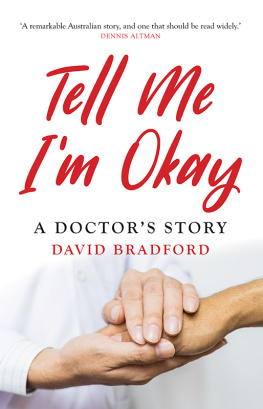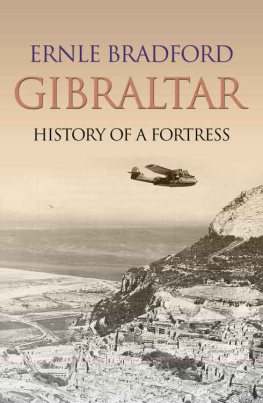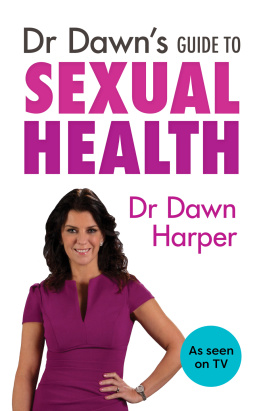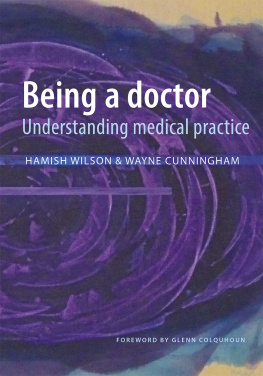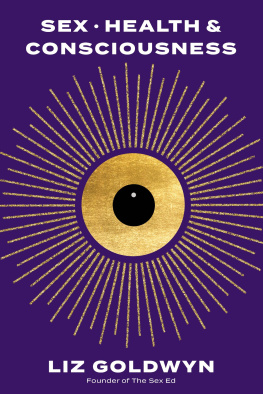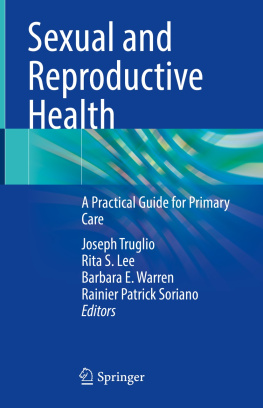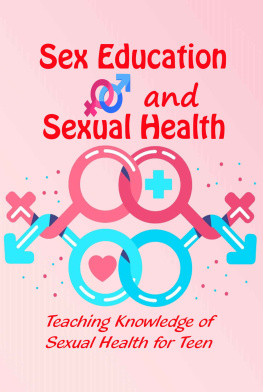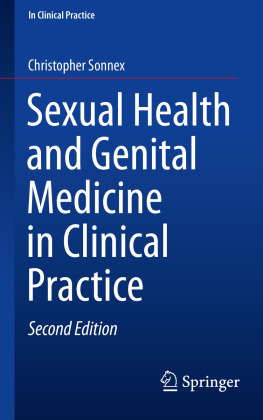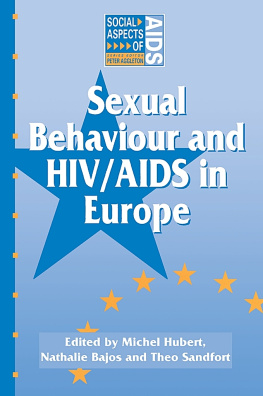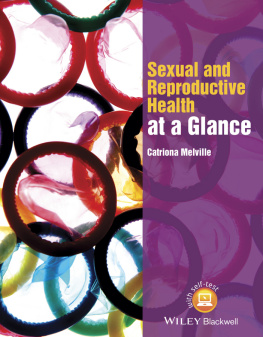Tell Me Im Okay
TELL ME IM OKAY
A Doctors Story
David Bradford

Copyright and Imprint Information
Tell Me Im Okay: A Doctors Story
Copyright 2018 David Bradford
All rights reserved. Apart from any uses permitted by Australias Copyright Act 1968, no part of this book may be reproduced by any process without prior written permission from the copyright owners. Inquiries should be directed to the publisher.
Monash University Publishing
Matheson Library and Information Services Building
40 Exhibition Walk
Monash University
Clayton, Victoria 3800, Australia
www.publishing.monash.edu
Monash University Publishing brings to the world publications which advance the best traditions of humane and enlightened thought.
Monash University Publishing titles pass through a rigorous process of independent peer review.
ISBN: 9781925523331 (paperback)
ISBN: 9781925523348 (ePDF)
ISBN: 9781925523355 (ePub)
www.publishing.monash.edu/books/tmio-9781925523331.html
Series: Biography
Design: Les Thomas
Cover design: Les Thomas

Contents
About the Author
D AVID B RADFORD was a gay Sexual Health and HIV/AIDS Physician in Melbourne and Cairns. He graduated as a doctor in 1965. After ten difficult years, including Vietnam, he discovered his specialty. During the AIDS epidemic, his patients became his life. In retirement, he and his husband live in Melbourne.
Authors Note
Some minor personal details and the names of all the patients who feature in the stories in this book have been changed, but the stories are as true and accurate as my memory allows. Ronald (not his real name), as a patient still living with HIV in Cairns, has read and approved the section detailing his case history. Doctors and other health professionals with whom I worked and who are mentioned in the book are referred to by their actual names. Most of those who appear within the text have had the opportunity to read and comment on the relevant section.
This book is dedicated to the many nurses and army medics I have worked with down the years, but especially Olga Anderson and Rita Quinn, Bob Allen and Alex (Chuck) Berry, Tom Carter, Beth Hatch and Peter Hayes, Jeni Mitchell and Tess Slater, Barbie Brayshaw and Paul Stephenson, and Chris Remington and Kel Browne. I could not have survived without them.
Acknowledgements
A great number of people have assisted by reading and comment-ing on earlier drafts of this book. I want to thank all of them, but especially my dear friend Glen Pike from London, Noah Riseman, and Raden Dunbar, who all gave a great deal of their valuable time reading my manuscript, correcting glaring errors, assisting with re- writing sections, critiquing my grammar and style, as well as being unfailingly helpful and encouraging. I also want to thank the following people who have read and commented helpfully on the manuscript in one or other of its many versions, namely Jeni Mitchell, Peter Hayes, Phil Carswell, Liz Christmas, Felicity Guthrie, Anne Mijch, my brother Philip and my cousin Lyn Bannerman. My colleague and much respected friend Dr Peter Greenberg has been a huge source of encouragement and support from the very start of the project. My editor at Monash University Publishing, Duncan Fardon, has been invaluable. As well, I want to thank Nathan Hollier, Laura McNicol Smith, Joanne Mullins, and all the team at Monash for their advice and ready assistance. Finally, my toughest but most loving critic has always been my husband Michael words are inadequate to thank him.
Part One
Pre-AIDS
Chapter One
First and Last
My very last patient, Sam, was an Asian man in his early twenties. He lay compliantly on the couch, exposing his nicely-rounded, naked buttocks. I feared they were all-too-slim for the present purpose, so I administered the penicillin injections as gently as I could, one into each cheek. Sam was lucky; he had the benefit of my forty-eight years experience. I let him rest for five minutes, then patted him sympathetically on the shoulder. He looked up, smiling. Thank you, Doctor. That very good injection. Not like last time very rough nurse in Taipei.
It was 2013, the afternoon I retired from medical practice. How strangely appropriate, I thought, that Sam should have had syphilis. The first patient I ever treated for a sexually transmitted infection also had syphilis. That had happened in 1967 when I was an inexperienced Australian army doctor in Vietnam. The consultation had taken place during a morning sick parade in the Regimental Aid Post (RAP) of an Australian Artillery Regiment in Nui Dat. I remembered that Gunner Len had acquired the infection in Bangkok during five days rest and recreation (R&R) leave.
The treatment for syphilis hadnt changed in forty-six years; my environment had changed a lot. While I was treating Len in the barn-like, concrete-floored aluminium RAP, it shook with the near-continuous blasts of heavy 155mm guns firing from the American base down the road. The never-ending whump-whump of helicopter blades reverberated overhead. By contrast, in 2013, the late-afternoon tropical sunlight filtered through the louvered windows of a well-equipped, purpose-built sexual health clinic in Cairns where all was quiet and peaceful.
Between my first and last case of syphilis, I have treated many patients with sexually transmitted infections (STIs) in Nui Dat, London, Melbourne, and Cairns. They were aged between thirteen and eighty-five: gays, straights, and transgendered people; female and male sex workers; office workers, labourers, housewives, single mothers, school children, doctors, lawyers, and even a few politicians. During the last twenty-five years of my working life, HIV infections made up the largest part of my practice, but the case-load always covered the full spectrum of STIs from pubic lice to tertiary syphilis.
Throughout my years of practice, people have often asked me why I decided to specialise in sexual health. The question is not surprising given that sexual health doctors are not held in the same regard as those who work in other medical specialties. The simple answer I always gave was obvious to me I did it because I liked it. More than that, I liked the patients. For example, I liked the eighty-five year old Polish orchestra conductor who caught gonorrhoea fifteen times, and I liked the big, black Brazilian man who hugged me, and kissed me full on the lips, when I told him his HIV test was negative. This spontaneous display of relief and happiness visibly shocked the very straight male medical student who happened to be sitting in with me that afternoon. Then, during the years 1985 until 1996, there were my numerous, memorable AIDS patients whom I could only watch helplessly as they disintegrated and died.
I remember too, without particular fondness but with grudging understanding, an angry businessman who acquired gonorrhoea in Indonesia, and then unwittingly passed it on to his pregnant wife. Nor could I help myself having a soft spot for the handsome
We sexual health physicians dont grow rich, but we have a wealth of stories wry, funny, and sad all illustrative of the human condition. This book tells many of my own stories, and describes the circuitous path I followed to eventually reach my chosen specialty. As well, Ive recounted the stories of some of my patients, among whom Gunner Len in Vietnam had the distinction of being the first, and Sam in Cairns the last, in a long line of always notable clients.
Next page
